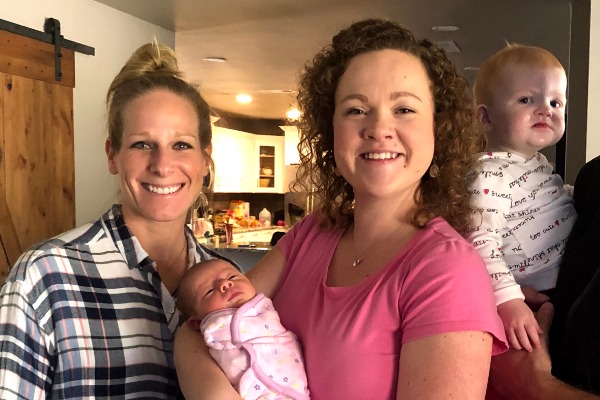Understanding Labor [How to Prepare]

As you’re preparing for the big day, it’s important to start thinking about your labor experience because understanding what labor is, knowing what to expect when labor occurs and what to do when labor begins can help you feel more ready when your due date arrive.
Labor is defined as the dilation (stretching and expanding) of the cervix. As the body prepares for labor, the uterus tightens and the cervix stretches. You may feel tightening, contractions or cramps prior to going into labor, but it technically is not labor until there is a change in the cervix.
Braxton-Hicks Contractions: False Labor Vs. the Real Deal
Braxton-Hicks contractions are typically sporadic contractions you may be able to feel when you place your hand on your abdomen. These contractions often occur during the third trimester of pregnancy. They can be painful but are typically not as strong as true labor contractions. They may increase in number and strength when the uterus is massaged.
In most cases, Braxton-Hicks contractions are irregular. They are usually short in duration (less than 45 seconds). The discomfort of the contraction may occur in various parts of your body, such as the groin, lower abdomen or back. With true labor, uterine contractions produce pain that starts at the top of the uterus and radiates over the entire uterus, through the lower back into the pelvis.
There are several ways to tell the difference between true labor and false labor. Be sure that you talk to your doctor or midwife about knowing the difference between the two. Here are some indicators of false and true labor.
|
False Labor |
True Labor |
|---|---|
|
Contractions do not get close together. |
Contractions get closer together. |
|
Contractions do not get stronger. |
Contractions get stronger. |
|
Contractions tend to only be felt in the front. |
Contractions tend to be felt all over. |
|
Contractions do not last longer. |
Contractions last longer. |
|
Walking has no effect on contractions. |
Walking makes the contractions stronger. |
|
Cervix does not change with contractions. |
Cervix opens and thins with contractions. |
How Long Will Labor Last?
The length of the first and second stages of labor, from beginning of cervical dilatation to delivery of the baby, can last 14-15 hours or more in a first pregnancy. For every story of a woman barely making it to the hospital in time or having a one-hour labor, there are many more women whose labor lasted 18-24 hours or longer.
The bottom line is that it is almost impossible to predict the amount of time that will be required for labor.
Timing Contractions
To time how long contractions last, begin timing when the contraction starts and end timing when the contraction lets up and goes away.
It is important to know how often contractions occur. There are two basic methods for timing contractions:
-
Note the time period from when a contraction starts to the time when the next contraction starts. This is the most commonly used method and typically the most reliable.
-
Note the time when the contraction ends and when the next one starts.
Ask your doctor which method they prefer. It is important to time your contractions before you call your doctor so they can decide when you should go to the hospital.
Helpful Information
Stages of Labor
First Stage
This begins when you start to have regular contractions that increase in frequency and intensity. Make sure you know how to time contractions. Usually labor will start off slowly, and you may not be sure that it is true labor. When the contractions are more intense and come more frequently, then you will be in the active phase of the first stage of labor.
Your doctor will give you guidelines as to when you should call. Some want you to go to the hospital as soon as your water breaks, and some want you to call when you have steady contractions that are a certain number of minutes apart.
The next phase of the first stage of labor is transition. Transition is the short, but hardest, part of labor. Your contractions will come very close together, but are not usually any stronger than the contractions of the active phase. By the end of transition, your cervix will be completely dilated to 10 centimeters, big enough for the baby's head to pass through.
Second Stage
This stage begins when you are completely dilated. You will begin pushing, and your contractions will get further apart and feel differently. Most women feel the urge to push if they have not had too much medication. If you have been medicated, you might or might not feel the urge to push. Your labor nurses will help you get ready to push at the right time (during a contraction). The end of the second stage will be marked by the birth of the baby.
Third Stage
Soon after the baby is delivered, the placenta will detach from the wall of the uterus. This can happen five minutes to an hour after delivery. You will be asked to give a few small pushes to help get the placenta out.
Labor and Adoption
If you’re placing your baby for adoption after giving birth, you may be unsure of how this process will happen at the hospital. Your first action should be to contact an adoption specialist, if you haven’t already. They’ll help you make a hospital plan that you’re comfortable with, so that your time in the hospital is as low-stress as possible. They’ll also walk you through what happens at the hospital when you’re planning to place your baby with an adoptive family.
“About a week before my due date [the adoptive parents] came to visit and be with me for the birth (scheduled C-section). My son’s new mom was with me in the operating room holding my hand when my son was born. It was such a happy day but sad at the same time,” said Donna, a birth mother who worked with American Adoptions. “I had given another couple the greatest gift imaginable and I wouldn’t be the one bringing him home. I am sure that I made the best decision possible for me and I wouldn’t change a thing.”
Labor is a physically, mentally and emotionally difficult time for women. Adoption is, too. That’s why each state has a required waiting period after your baby’s birth before you may sign adoption paperwork. This gives you some time in between the birth of the baby and finalizing your adoption decision so that you can recover, reflect and allow any medications from labor to leave your system so you’ll have a clear head to be confident about your choice.
“It was heartbreaking, but there was never a time that I didn’t feel like it felt right,” Randi said about completing the adoption following delivery. “It was hard because you still have all these hormones running through you and all these motherly instincts. And It’s like your brain is telling you one thing, and your body is telling you another thing. I think that was the hardest part.”
Your adoption specialist will always be by your side to help you work through these difficult emotions. Your specialist will never rush you to complete your paperwork, and will wait until you feel 100% ready.
Remember that just like every part of your adoption plan, the details of your hospital plan are always in your control when you’re choosing adoption for your baby.
To learn more about what labor and giving birth is like when you’re placing your baby for adoption, contact us now online or by calling 1-800-ADOPTION to get free information.
Disclaimer
Information available through these links is the sole property of the companies and organizations listed therein. American Adoptions provides this information as a courtesy and is in no way responsible for its content or accuracy.






































